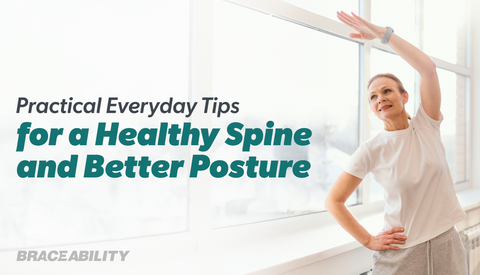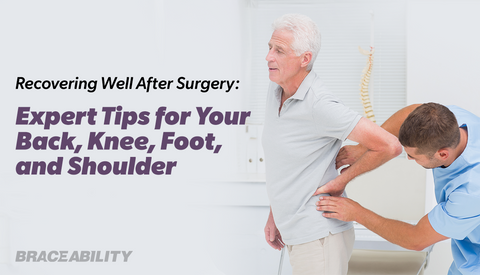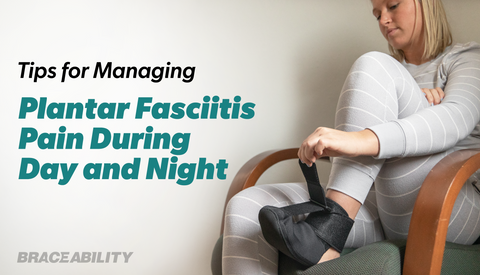What Even Is Spinal Stenosis?
The word ‘stenosis’ in medical terms refers to an uncommon narrowing of a passage in your body. Spinal stenosis is when there is narrowing in between the spaces of your vertebra. This narrowing leads to extra pressure on your spinal cords and nerves, causing you pain and discomfort. There are three different types of spinal stenosis: foraminal, central, and lateral. All three consist of narrowing in your spine but more specifically are in different regions of your spinal canal. Read more about the background of spinal stenosis!

The Most Common Type of Spinal Stenosis: Foraminal Stenosis
Foraminal narrowing stenosis of the spine is the most common type of spinal stenosis. Neural foraminal stenosis occurs in the passageways located on each side of your vertebra. It's no surprise that your spinal passageways are very important to your everyday movements. These allow your nerves to exit the spinal cord and go to the rest of your body. When these are narrowed, your nerves become trapped, ultimately leading you to lose your ability to feel or move around. Typical symptoms of foraminal stenosis c5-c6 include numbness, weakness, or tingling in regions such as your arms or legs. In addition, the pain may increase over time slowly and increases when you’re doing activities that may irritate that nerve. Foraminal narrowing of the spine is a result of the natural aging process or another spinal condition such as bone spurs,
arthritis,
bulging discs,
herniated discs, and trauma to the spinal region. Treatment options for bilateral foraminal stenosis can vary from individual to individual. Most individuals can ease their pain caused by spinal foraminal stenosis by altering their activities. Here are some other ways to reduce your discomfort from lumbar or cervical foraminal narrowing:
- Anti-inflammatory medications can help initially reduce your pain.
- Avoid activities that may strain or wear out your back even more such as weightlifting, football, biking, etc.
- Wear supportive shoes!
- Losing weight may also be an option to help decrease the amount of weight that is placed on your spine.
- Make sure you stay hydrated while exercising and even on a daily basis!
- Try Pilates, yoga, or another type of exercise in which your body is strengthened and stretched.
- Correcting your posture! By simply wearing a posture brace, you can train your muscles to stand upright in the right position to help reduce the stress on your back.
- Injections can help focus in on the direct narrowing region to help alleviate your pain.
- Physical therapy is a great tool to help design the perfect plan for your specific condition.
- Wearing a back brace for spinal stenosis is a great tool in helping reduce your discomfort caused by the narrowing of your spine. By wearing these braces, the extra strain or stress that is placed on your spine from your daily activities decreases, providing relief. Here are the best spinal stenosis treatments we recommend!
If these methods above prove to be ineffective or your condition worsens,
spinal stenosis surgery is an option for those with severe bilateral neural foraminal stenosis. Foraminal stenosis surgery would consist of an anterior discectomy and a spine fusion. With this, space in your foramen is opened up to give your nerves more room to travel throughout your body. Keep in mind, it's important to speak with your doctor in order to decide the best treatments or surgery options are for you!
So... Now What Is Central Stenosis?
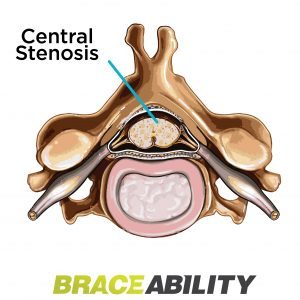
Just like it sounds, central stenosis occurs in the central canal. This main canal essentially protects your spinal cord... sounds like a pretty important area right? The most common regions of your spine for central stenosis narrowing to occur in is your cervical (neck) and lumbar (lower back) regions. Typically, those who over or around the age of 50 have a higher chance of developing central canal stenosis due to your spine weakening over time. Symptoms of central stenosis are very similar to foraminal stenosis. For individuals suffering from narrowing of the central canal, symptoms typically include pain, tingling, and numbness that could occur in your arms, legs, and buttock. Just as symptoms of central spinal stenosis are closely similar to foraminal narrowing, so are the treatment options. For an individual with mild central stenosis, conservative treatment options may be the first step in hopes to relieve your pain. Such conservative methods for central stenosis treatment may include:
- Physical therapy
- Anti-inflammatory medications
- Exercises to help strengthen your core, back, and shoulders
- Avoid activities that may place a greater strain on your back such as football, wrestling, and kickboxing
Unfortunately, some individuals suffer from a severe case of central canal stenosis. If the conservative methods mentioned above don’t help to reduce your discomfort, surgery is an option. For central stenosis icd 10 surgeries, it’s very common for your doctor to perform decompression surgery (also known as a laminectomy). This surgery helps open up space to allow your nerves to move freely throughout your spine. Want to learn more ways to manage your pain in your lumbar or cervical region? Check out our blog full of tips on
ways to get rid of your leg pain!
Third Type of Spinal Stenosis: Far Lateral Recess Stenosis
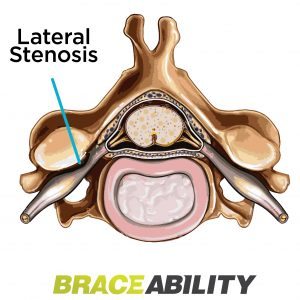
The third and last type of spinal stenosis is called far lateral recess stenosis. This type of stenosis occurs on the side of your spinal canal, the lateral recess. It can be common for another condition to occur along with or be a cause of lateral stenosis. These conditions may include bone spurs, bulging discs, degenerative disc disease, etc. Symptoms of far lateral recess stenosis to no surprise are indeed similar to the other two types of spinal stenosis. Pain, weakness, and discomfort will gradually over time. In addition, a very common symptom of lateral recess stenosis is tingling or heaviness in one or both of your legs, thighs, or buttock. Treatments for far lateral recess stenosis include exercises, hot and cold therapy, anti-inflammatory medications, & supports such as back braces. These are easy, at home remedies to help you say goodbye to your pain from narrowing of the spine. Surgery such as the laminectomy mentioned above may be used for individuals whose pain persists or worsens. Again, we advise speaking with your doctor about the many different surgery options to help determine which is the right one for your condition!












